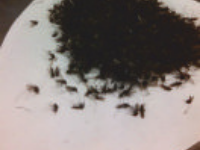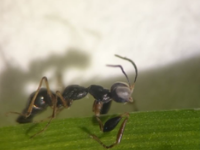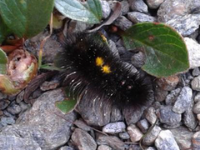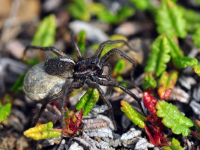Featured Arthropods
Read on and learn more about the biology and life history of some of the charismatic arthropods found in the tundra.
Aedes nigripes (Zett 1840), Diptera: Culicidae
Aedes nigripes (Zett, 1840) is probably the most abundant Arctic mosquito (Vockeroth 1954) and is found all across the Arctic. Its larvae grow rapidly in snowmelt tundra ponds during early summer and the adult females emerge to fiercely seek blood from caribou and other wildlife. Autogeny (i.e., reproducing without a blood meal) has been documented in this species (Corbett 1964, 1967) although it is unclear if this presumed adaptation to low blood-meal density is present in all populations (Culler, pers. obs.). In Greenland, the timing of pond thaw in spring strongly predicts its emergence time, and the number of immatures that survive to the adult stage depends on pond temperature and mortality from beetle predators (Culler et al. 2015).
L. Culler
References and links
- Corbet, P.S. 1964. Autogeny and oviposition in Arctic mosquitoes. Nature 669.
- Corbet, P.S. 1967. Facultative autogeny in arctic mosquitoes. Nature 215:662-663.
- Culler, LE et al. 2015. In a warmer Arctic, mosquitoes avoid
increased mortality from predators by growing faster. Proceedings of the Royal
Society B. 282: 20151549 - Vockeroth, J.R. 1954. Notes on the identities and distributions of Aedes species of
northern Canada, with a key to the females (Diptera: Culicidae). Canadian
Entomologist 86:241-255. - Why Giant Mosquitoes Are Suddenly Swarming Greenland
- Why the Arctic’s Big Mosquito Problem Is Getting a Lot Worse
- Arctic Mosquitoes Are Growing Faster With Rising Temperatures
Gonatopus brooksi (Olmi 1984), Hymenoptera: Dryinidae
Parasites are a world of wonders and parasitic wasps are no different. The larvae of the Dryinid wasps are known to parasitize leafhoppers (Andersen & Nielsen 1987). In this bizarre family we find the tiny wasp Gonatopus brooksi (Olmi, 1984; Hymenoptera: Dryinidae). The female wasp grasps leafhoppers (presumably Psammotettix lividellus (Andersen & Nielsen 1987)) with her front tarsi, which has been modified into a pair of pincers, and quickly paralyzes the insect for the egg laying process. The larvae grow on the outside of nymph and adult leafhoppers in a small sack, from where they eat the tissue of the leafhopper. The male of this wasp species is not yet known, which makes these little guys ever more fascinating (Böcher et al. 2015).
Thanks to Massimo Olmi we know that this species has only been recorded 20 times throughout the USA (16 records (Olmi unpublished)), Canada (2 records (Olmi, unpublished) and once (Olmi 1984) in Greenland (Andersen & Nielsen 1987)). This
genus, however, will be updated next year by Olmi, partly due to this year’s field work in Narsarsuaq, Greenland. During this summer 17 observations of G. brooksi were made through pitfall trapping by a couple of students of Aarhus University. When looking back, 3 individuals were also found in the material collected from pitfalls in 2014 in Narsarsuaq. Some of the specimens have been confirmed by Olmi through photos. Together these observations have doubled the amount of records of this species. If the males have not been found before next summer, it should be fairly possible to find it during next year’s field work.
Mathias G. Skytte
References and links
- Böcher, J. et al. 2015. The Greenland Entomofauna: An identification Manual of Insects, Spiders and Their Allies. – Fauna entomologica Scandinavica; v. 44
- Andersen, M. & Nielsen, P. 1987. Gonatopus brooksi Olmi 1984 found in Greenland (Hymenoptera, Dryinidae). – Ent. Med. 55:21-22.
- Olmi, M. 1984. Revision of the Dryinidae – Memoirs of the American Entomological Institute 37:1-1913-
- Olmi unpublished. A new revision of the Gonatopus genus is coming out in 2017.
Gynaephora groenlandica (Hübner 1819), Lepidoptera: Erebidae
If there is one charismatic Arctic invertebrate, it has to be
the Arctic woolly bear moth, Gynaephora groenlandica
(Wocke, 1874; Lepidoptera: Erebidae: Lymantriinae). G. groenlandica is one of two species in the genus
Gynaephora occurring in North America. G. groenlandica was thought to be a High-Arctic endemic
species until recently, when a new subspecies was described from alpine areas in the SW Yukon (G. g.
beringiana (Barrio et al. 2013); see also Lukhtanov and Khruleva (2015) for a taxonomic revision). Still, the Arctic woolly bear moth is one of the best examples of a cold-adapted species, with overwintering caterpillars that have served as model organisms for understanding physiological adaptations to freeze tolerance (Kukal et al 1988, 1989).
G. groenlandica has an extraordinarily extended developmental period of up to 7 years (Morewood and Ring 1998). Low temperatures constrain the feeding activities and metabolism of caterpillars during the short Arctic growing season, and biotic factors like parasitism and phenology of its host plant further confine larval activity to a brief period after snowmelt. To avoid the peak of activity of adult parasitoids (Kukal and Kevan 1987) during mid-summer, caterpillars spin silky hibernacula and become dormant until the next spring (Kukal and Dawson 1989).
Isabel Barrio
References and links
- Barrio, I. C. et al. 2013. First records of the Arctic moth Gynaephora groenlandica (Wocke) south of the Arctic Circle – a new alpine subspecies. – Arctic: 1–15.
- Bennett, V. A. et al. 1999. Metabolic opportunists: feeding and temperature influence the rate and pattern of respiration in the high arctic woollybear caterpillar Gynaephora groenlandica (Lymantriidae). – J. Exp. Biol. 202: 47–53.
- Kukal, O. and Kevan, P. G. 1987. The influence of parasitism on the life history of a high arctic insect, Gynaephora groenlandica (Wocke) (Lepidoptera: Lymantriidae). – Can. J. Zool. 65: 156–163.
- Kukal, O. and Dawson, T. E. 1989. Temperature and food quality influences feeding behavior, assimilation efficiency and growth rate of arctic woolly-bear caterpillars. – Oecologia 79: 526–532.
- Kukal, O., Duman, J.G. and Serianni, A.S. 1988. Glycerol metabolism in a freeze-tolerant arctic insect: An in vivo 13-C NMR study. – J. Comp. Physiol. B 158: 175-183.
- Kukal, O., Duman, J.G. and Serianni, A.S. 1989. Cold-induced mitochondrial degradation and cryoprotectant synthesis in freezetolerant arctic caterpillars. – J. Comp. Physiol. B 158: 661-671.
- Lukhtanov, V. A. and Khruleva, O. A. 2015. Taxonomic position and status of
- Arctic Gynaephora and Dicallomera moths (Lepidoptera, Erebidae, Lymantriinae). – Folia Biol. (Praha). 63: 69–75.
- Morewood, W. D. and Ring, R. A. 1998. Revision of the life history of the High
- Arctic moth Gynaephora groenlandica (Wocke) (Lepidoptera: Lymantriidae). – Can. J. Zool. 76: 1371–1381.
- Caterpillar survives frozen death
Pardosa glacialis (Thorell, 1872), Araneae: Lycosidae
Pardosa glacialis (Thorell, 1872) is described by Leech (1966) as being eurytopic, but at Zackenberg in northeast Greenland it is found more abundantly in mesic heath (pers. obs.) and is holarctic in distribution (World Spider Catelog Version 16). Leech described an individual’s behaviour as follows: “Mating was never observed in P. glacialis, but one male which had repeatedly been shunned by all females, began courting a large male Chironomid, which was lying on its side almost dead. The male eventually mounted the fly in the usual Pardosa manner, it then discovered the mistake and ate the fly.” Previous year’s snowmelt is a good predictor of body size variation in this species and females are more strongly affected by environmental variation (Høye et al. 2009, Høye and Hammel 2010).
References and links
- Leech RE. 1966. The spiders (Araneida) of Hazen Camp 81o49’ N, 71o 18’ W. Quaest Entomol 2:153-212
- World Spider Catalog 2015. Natural History Museum Bern, version 16
- Høye TT et al. 2009. Climate change and sexual size dimorphism in an Arctic spider. Biol Lett 5:542-544
- Høye TT & Hammel JU 2010. Climate change and altitudinal variation in sexual size dimorphism of arctic wolf spiders. Clim Res 41:259–265



